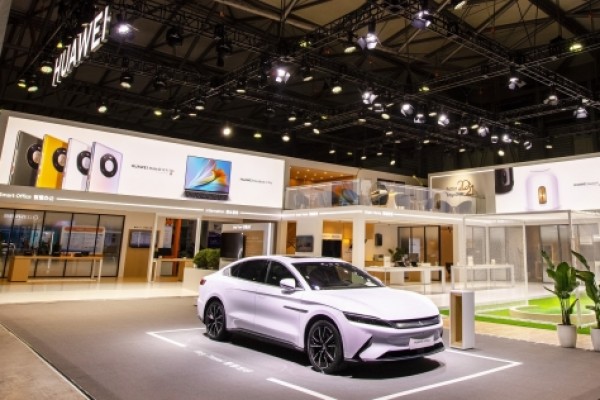| Huawei debuts Smart Home Project at MWC Shanghai 2021 | |

| Author: CSEBA / SEEbiz |
| 25th February 2021 |
| SHANGHAI - Today, Huawei's first Smart Home project was unveiled at MWC Shanghai 2021. Following the core design concept of building a smart home, the installation includes a living room, kitchen, study, home gym, entertainment room, and garage, and covers an area of 550 m2 in total. |
|
Using wireless technologies, Huawei's products, including phones, PCs, tablets, watches, smart speakers, and the Vision TV range, are integrated with products from Huawei ecosystem partners to provide a comfortable, intelligent and immersive Smart Home experience. Smart home represents a key part of Huawei's Seamless AI Life Strategy. The Smart Home project, which integrates innovative technologies such as HUAWEI HiLink, HarmonyOS, and HUAWEI HiCar, is a prototype for what a smart home can be in the Internet of Everything era. In the living room, it just takes a few words to wake up the smart assistant and enable the Back Home Mode. In this mode, the air purifier and warm light are turned on, and curtains are closed. These connected devices can all be controlled using the smart assistant. In the kitchen, you'll find a full complement of HarmonyOS-based household appliances. Establishing a network connection is as simple as tapping your phone against those devices. A card will be displayed, from which you can control them at any time. The steam oven, high-speed blender, and other kitchen appliances have recipes built in, making it easier than ever to cook like a master chef. In the study, phones can be connected to a HUAWEI MateBook and HUAWEI MatePad Pro through Multi-Screen Collaboration, enabling data transfer between devices. The Smart Multi-Window feature of the HUAWEI MatePad Pro allows you to run two apps on one screen, on top of which two floating windows can be displayed. This saves you from the hassle of switching between different apps, and enables you to take notes and use the calculator and browser in floating windows while taking online courses. In the entertainment room, the combination of a 65-inch 4K Huawei Vision TV and HUAWEI Sound X speaker immerses the user in high-definition images and surround sound. You can select a film from the AiMax Cinema section of the Huawei Video platform and enjoy a home cinema experience. In the gym, there is a space for practicing your golf swing while the HUAWEI WATCH GT 2 Pro records the number of swings, speed, and calorie consumption. The HUAWEI WATCH FIT can identify when the wearer is exercising on a rowing machine and provide cardio/anaerobic training results, status evaluation, and recommended recovery time, giving you personalized guidance for your workout. There is another HUAWEI Vision TV in the gym, and its AI Fitness feature is used to monitor your exercise routine, using bone joint recognition technology to provide actionable, real-time guidance during yoga and other exercises. When you enter the garage, you can open the door of your car with your phone, and your mobile apps and services, such as navigation and music, automatically switch to the car. You can also control your IoT devices at home through the cards displayed on the home screen of the dashboard. For example, you can turn on the air conditioner and lights remotely when you are on your way home. In the coming Internet of Everything era, living in a smart home is no longer merely about installing smart devices at home. The focus is now shifting to how those devices will form a virtual world and become an extension of human senses, as well as improving how we interact with those devices by developing a repertoire of intuitive voice and gesture commands. Smart devices powered by AI sensing and computing capabilities can sense users' behaviors, monitor their health indicators, and even understand their emotions, to better grease the wheels of daily life. Since Huawei announced its entry into the smart home space in 2018, its smart home ecosystem has grown substantially. The release of HarmonyOS promises to accelerate this ecosystem development. Currently, Huawei has more than 800 partners in its HiLink platform, covering over 220 million IoT devices. HarmonyOS has already attracted more than 20 hardware vendors and 280 application vendors to participate in Huawei's ecosystem. In 2021, it is expected that more than 40 mainstream brands will work with Huawei to provide 100 million HarmonyOS-based devices to millions of households. The MWC installation shows that Huawei is going all in on smart home technologies. Technologies such as HUAWEI HiLink and HarmonyOS have laid the foundation for Huawei smart home, and the company sees artificial intelligence soon becoming as indispensable to home life as running water and electricity. |